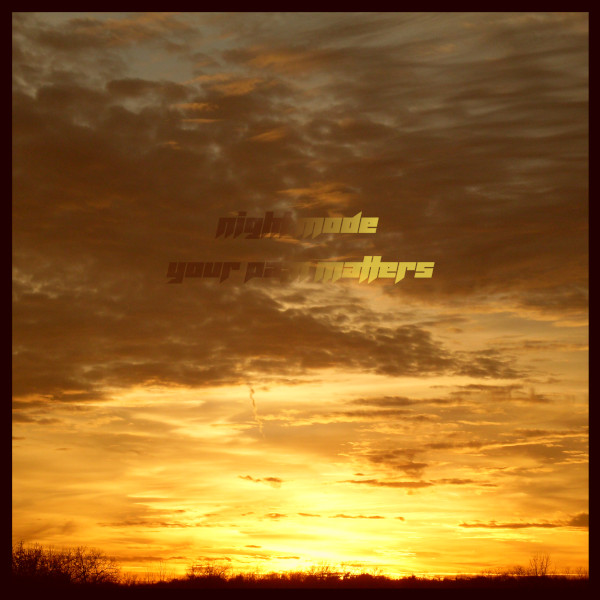Enjoy these quarantine videos from An Evening At Home with Howie and Scott, inspired and edited by JT Hills!
-
When Breathing and Blues or Astroblue Videos
-
Listening Party: “Friendship Acid” by L.U.V. C.R.A.F.
-
We Now Return To Your Regularly Scheduled Programming
mrfuriousrecords.com has been down for anywhere from a few minutes to 12 days. I just discovered this half an hour ago, and have fixed it, so we’re back! I apologize for the interruption.
I didn’t need my site backup for the fix, but I was happy to have a recent one in case I had needed it. Back your stuff up!
-
Listening Party: Dark Satellites, “May You Live In Interesting Times”
-
“Orbital Debris Vol. 1” and “Your Pain Matters” Arrive on Streaming Platforms
All the latest Night Mode is now available on your preferred streaming service, links below.


-
“Orbital Debris Vol. 1” Listening Party
It’s a preview. It’s talking about music. It’s gear. It’s a deep dive. It’s an interview.
I don’t know how to explain it, but I’m excited to share it with you. Nate, KC engineer and artist Royce Diamond, and I listened to the record together and recorded our conversation.
Come for the jams, stay for the hang, and let us know what you think because we feel like we could do some more of these.
-
Hear 3 Songs from Asterales x Night Mode “Orbital Debris Vol. 1”
Next Friday, 8/14, we’re dropping the first of several (!) quarantine releases. It’s a synths-‘n-drums collaboration between Nate Holt (Asterales, Life Absolute, Approach) and Howie and you can hear three songs right now:
-
“Dimension” Processing In Any DAW
The Boss Dimension C / Dimension D effects are famous for their seemingly unmoving modulation, providing a widening and deepening* effect on sounds without being warbly like a traditional chorus effect.
Here’s how the same effect can be created and customized in almost any DAW. I use this often for turning mono synth signals into stereo.

It takes four channels of audio. In Reaper I do this all in one track, with an extra set of track channels and plug-in pins. In ProTools you might use a send from the main track to a stereo auxiliary or two mono auxiliaries. The details will vary; the important thing is four channels, Ls panned 100% left and Rs panned 100% right.
The signal path:
Source – Can be mono or stereo
Split/send – Duplicate both the left and right channels of audio so there are 4 total (4 track channels in Reaper, original track plus two mono aux tracks in ProTools, etc.). One L/R pair (the “dry” signal) will go straight through to the mix stage with no further processing
Highpass (“wet” signal) – Adjust this to taste. On an individual sound source like a mono synth sound this could be skipped. On a full mix with drums, bass, and other sounds, I probably wouldn’t set it much lower than 140 Hz but I might set it higher; 200, even 300 Hz. The reason for this is to keep bass frequencies from bouncing back and forth between left and right
Chorus – The different sides of the wet L/R pair need different chorus settings, so you’ll almost certainly need two instances of your chorus plugin (this is where two mono auxes can be helpful in ProTools, rather than a stereo wet aux). Both need to be set to 100% wet output. Adjust depth to taste but use the same depth on both sides. To the best of my knowledge the original Dimension effects use the same medium-slow chorus rate/speed on both sides, with the LFO polarity inverted for one side (so when the L channel is high the R channel is low, and vice versa). I like just using slightly different rates for a less predictable, almost polyrhythmic type of movement
Invert polarity – This is key; invert the polarity of *one* of the wet channels. This has the result of phase-cancelling frequencies that are the same in both channels, leaving only the differences (like mid/side processing)
Mix – Bring it all together. In Reaper I use an 8-to-2 track channel mixer to mix back down to stereo. In ProTools with auxes your “mixer” is just your master track, and you mix via the volume levels on your dry and wet tracks. The more wet-to-dry in the mix, the wider the stereo image will be.
By creating our own processing instead of using a Dimension unit we can have greater clarity (bypassing the hardware’s inevitable amp stages and filtering) and control (setting our own high pass cutoff, chorus rates, and mix levels), making new sounds in the process.
My hat is off to whoever came up with the idea for this circuit, though, it’s truly brilliant and sounds fantastic.
*Creating “dimension,” natch
-
Meet the Thereatari
The Thereatari is my own adaptation/revision/expansion of the classic 555 timer / Atari Punk Console noise synth with photoresistor control of 4 parameters, tone control, alternate voicing (gives alllllmost a full chromatic octave on the fine pitch control), current starve, and control voltage inputs for the oscillators.
I had been doing research for this project before the lockdown, designed and breadboarded it in late March / early April, ordered parts, made some other music, soldered, made some other music… and finally got it troubleshot and put together last weekend.
The jacks on the sides are separate passive mixers; in addition to the noise synth, this box is designed to pull together my Monotribe / Volca Bass / pedals mini rig.
They were out of blue 1900 knobs when I ordered parts so the “Fine” tuning knob is temporarily black.
More music with the full mini rig is definitely coming. Even in the half-assembled state it’s been in it is super fun to jam on.
Three big album releases are coming in fairly short order, too.
< sunglasses >
-
This is how Night Mode records start sometimes

- Piece of gear (Dreadbox Utopia in this case, the orange thing)
- List of things it can do musically (additional things will be discovered in the course of #3 below)
- Patch up something from the list and start messing around until a piece emerges
If history is any guide, spontaneously discovered sounds will add between half again as many and double the patches on the initial list.
I haven’t started this record yet, and I’m in no rush to. Plenty going on, and I’m trying to decide if this is a collaboration or a solo jawn. It’ll be waiting for me when I’m ready.
-
Howie & Scott Take You To Church
A few weeks ago JT Hills reached out and asked us to record a stay-at-home version of “Blues or Astroblue” for Pride. We threw in “When Breathing” for good measure. They’re featured in the United Church of Big Rapids worship service this morning, embedded below, with stand-alone videos to follow.
-
New Night Mode Friday
On Friday we will release Night Mode’s Your Pain Matters in celebration of Bandcamp’s fee waiver. We hope you’ll add it to your list of purchases on Friday!

Your Pain Matters is my follow-up to Dirac Spike. It’s a solo Night Mode effort recorded from March to July 2017, with the setup* used on the first Night Mode trio jams** and shows*** plus some overdubs****.
* Alesis Micron, Korg Volca Bass, Poly app for iPad, effects pedals
** What became Load Exceedance and Load Transcendance
*** April 2017
**** Rhodes, guitar, etc.
Musically and emotionally, Your Pain Matters is really the beginning of my story with making instrumental synth music. I absolutely stand by Dirac Spike but it was only a first experiment, and all of its pieces are based on the Poly app. (The app is fun, but I have not used it since Dirac Spike.)
For Your Pain Matters I began writing and performing parts for synthesizer with no sampling or sequencing; just me, at the keys & knobs, coming up with sounds and playing/recording live. This is largely what I continued to do for several more albums yet to be released, and am still doing. I did a bunch of it last weekend.
For the few who might care to trace Night Mode’s sonic development, here’s an attempt to sort out who was doing what, when. Of course reality was and is messier than can be fit into these boxes. We’ve had this idea of a Drew solo > Howie solo > Some type of collaboration (duo or trio) release cycle; Capsule was a departure from that, and it seems likely we’ll continue to deviate from that idea. It was a cool plan, but it doesn’t line up well with the pace at which we finish things individually or together.
Drew Howie Damon (Collaboration) Feb – Dec ’15 OTHER Jan – Aug ’16 Dirac Spike Feb ’17 Duo (H/Damon) –
(Untitled/Unreleased)Mar ’17 Trio –
Load Exceedance
Load TranscendanceMar – Jul ’17 Your Pain Matters ?? – Jul ’18 Gentleman Scientist (there’s a Drew/Damon
noise / Marshall reamp /
drums project in
here somewhereJan – Apr ’18 Working Bears Or Barely Working Jan ’18 – Mar ’19 Only Mostly Dead
Come In Alone / Stuck On You (Sep ’18)Jun – Nov ’19 Not One Person Left Out Jan-Feb ’20 Duo (Drew/H) –
CapsuleMar ’20 Duo (Drew/H) –
(Merritt/Unreleased)In progress:
Seen Heard and Known,
Monotribe record(s) (Oct ’19 – ??),
AX60 record (Nov ’19 – ??),
Medusa record (Apr ’20 – ??),
Noise record (Mar ’20)
